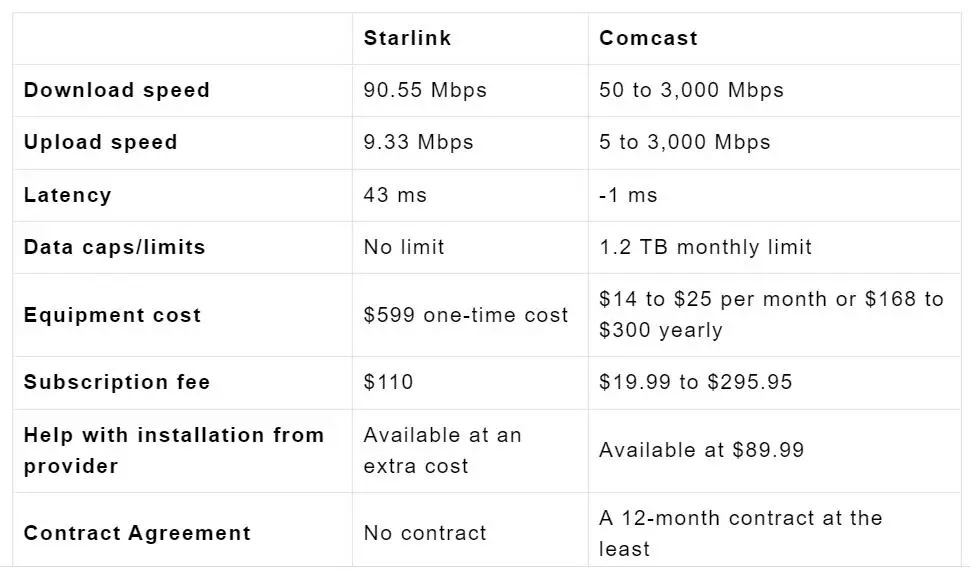SpaceX’s Starlink has gained much traction over the years. Undoubtedly, new competition is always beneficial to users. In this case, many in inaccessible rural areas can now enjoy internet services. But how does Starlink compare to compast (Xfinity)? Read on to learn more about Starlink versus Comcast.
Table of Contents
- What Is Starlink and What Does It Offer
- What Is Comcast (Xfinity) and What Does It Offer?
- Starlink Vs. Comcast
- FAQs
- Conclusion
What Is Starlink and What Does It Offer
Starlink is an advanced broadband service powered by Elon Musk’s SpaceX. Interestingly, its satellites’ unique positioning in the low earth orbit (LEO) means they’re closer to the earth. Subsequently, this affords it superior broadband capability compared to other satellite internet services.

Image of satellites in space
Additionally, Starlink satellite broadband services are available worldwide. Also, Starlink projects gigabit speeds, wider coverage, and lower latency. And with each satellite launch, the service gets better.
What Is Comcast (Xfinity) and What Does It Offer?
Comcast is a super high-speed internet service. Unsurprisingly, it’s used by 40% of Americans. It started by providing cable services focused on sports broadcasting and programming and Olympics coverage in the 1960s. Then, in the 90s, it ventured into internet services (Xfinity internet), quickly gaining popularity in the broadband market. It uses fiber and Cable.
Starlink Vs. Comcast

Reliability
Starlink is vulnerable to weather elements, solar phenomena, and trees, buildings, and other objects that obstruct a clear signal path like all satellite broadband services.
On the other hand, Xfinity’s internet relies on Cable or fiber. These only get affected by earth-bound weather elements and natural disasters. In this regard, Xfinity is more reliable.
Speed
While it does not currently offer gigabit speeds, Starlink speeds are also fast and stable.
On the other hand, although Xfinity Gigabit plans boast super high speeds of 1.2 to 3 Gbps, the fiber-optics service is only available in some cities. Further, the speeds differ from one location to the other depending on network capacity.
Availability
Xfinity has over 8 million hotspots around the country and is available in 39 states. However, it does not reach those in very remote areas or terrains where installing Cable, or fiber-optic equipment is impractical.
On the other hand, Starlink is available in all terrains and hard-to-reach areas. Moreover, it’s available outside the US, and the goal is worldwide accessibility.

Image of a remote, hard-to-reach area
Suitable For
Comcast customers who want to bundle their TV or home security system with Comcast internet can enjoy attractive discounts. In addition, they might qualify for a free self-installation Xfinity internet kit. Also, Xfinity offers flexibility with various price plans to suit different budgets.
On the other hand, Starlink is the best option for people living in remote out-of-reach areas where cable or fiber infrastructure is unavailable.
Customer Service and Satisfaction
Although Starlink has no phone support, its support team responds quickly to emails, and you can even get a callback. Plus, reports indicate that the support staff understands customers’ problems better and is more helpful.
In contrast, while Xfinity has 24/7 phone support, you’re likely to stay on hold long, which is frustrating.
FAQs
Starlink Vs. Comcast (Xfinity): What Are the Disadvantages of Starlink?
Like all satellite broadband services, Starlink internet scores low in reliability. That’s because, as mentioned earlier, it’s susceptible to weather, solar phenomena, and any obstructions to its signal path.
Also, there’s no flexibility with Starlink installation costs or subscription fees. Instead, users pay a flat rate for equipment and subscription.
Starlink Vs. Comcast (Xfinity): How Fast is Starlink Internet Compared to Cable?
When you compare Starlink to Cable, generally, Cable is faster. However, because cable internet relies heavily on network bandwidth, speeds can slow down significantly when several subscribers share the same network signal.

Image depicting shared network signal
Starlink Vs. Comcast (Xfinity): Is Starlink Faster Than Comcast?
Undoubtedly, the internet speeds are comparable to Starlink for Comcast’s lower price plans. However, Comcast has several plans offering 300 Mbps and above, with some offering gigabit speeds of up to 3,000 Mbps, way above Starlink’s 250 Mbps.
Conclusion
Now you understand better how Starlink compares to Xfinity. Granted, both services are fast. But Comcast has price plans offering super-fast speeds. Additionally, Comcast has varying price plans to suit different budgets. However, although Comcast is widely available, it only serves the US, while Starlink is available in other parts of the world, including very remote areas.
